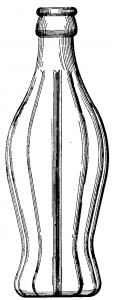 Design patents seek to protect the appearance of an article of manufacture, such as a product or a portion of a product. Therefore, design patents consist mostly of drawings of the invention with a small amount of text. The drawings mostly define the scope of protection that will be provided under the design patent. Therefore, the details of the drawings for design patents are very important.
Design patents seek to protect the appearance of an article of manufacture, such as a product or a portion of a product. Therefore, design patents consist mostly of drawings of the invention with a small amount of text. The drawings mostly define the scope of protection that will be provided under the design patent. Therefore, the details of the drawings for design patents are very important.
Surface shading in the drawings may be important to determining whether the patent design covers a particular third party product (e.g. an alleged infringer). The patent rules provide regarding design patent drawings, “Appropriate and adequate surface shading should be used to show the character or contour of the surfaces represented.” MPEP 1503.02. The rules further provide, “Lack of appropriate surface shading in the drawing as filed may render the design nonenabling and indefinite ….” If the patent application is deemed nonenabling or indefinite a patent may not be granted by the patent office or the resulting patent may be invalid. Therefore, drawings showing only perimeter boundaries with a black line may not be sufficient. The drawings may need to show surface shading with the appropriate shading techniques accepted by the office.
There are two principal type of shading: line shading and stippling (the use of dots). The rules provide “Spaced lines for shading are preferred.” 37 C.F.R. 1.84(m). The rules continue, “These lines must be thin, as few in number as practicable, and they must contrast with the rest of the drawings.”
U.S. Patent D48,160Â is a design patent on a classic bottle of The Coca Cola Company, which shows the use of line shading. Closely spaced thin vertical shading lines are provided adjacent the valley of each of the vertical grooves to show that the surface curves toward each valley. Closely spaced thin horizontal lines are provided in three horizontal locations at the top of the bottle to show vertical surface curves at horizontal locations near the top opening.
 U.S. Patent D526,178 provides another example of shading in a design patent. Line shading is predominately used. As the electric drill illustrated has many different curved surfaces, many shading lines are used to show those curved surfaces.
U.S. Patent D526,178 provides another example of shading in a design patent. Line shading is predominately used. As the electric drill illustrated has many different curved surfaces, many shading lines are used to show those curved surfaces.
 U.S. Patent D190,563 shows the use of stippling (dots) as shading in a design patent for a car. Shading is providing by varying the density/spacing of the dots. You can see the dots are more closely spaced to show the horizontal fins above each wheel. The dots are more dispersed in other areas, such as the mid-door areas.
U.S. Patent D190,563 shows the use of stippling (dots) as shading in a design patent for a car. Shading is providing by varying the density/spacing of the dots. You can see the dots are more closely spaced to show the horizontal fins above each wheel. The dots are more dispersed in other areas, such as the mid-door areas.
As the details of the drawings are very important for design patents, care should be taken in creating the drawings. The use of a professional patent drawings draftsperson is often appropriate to ensure high quality drawings.